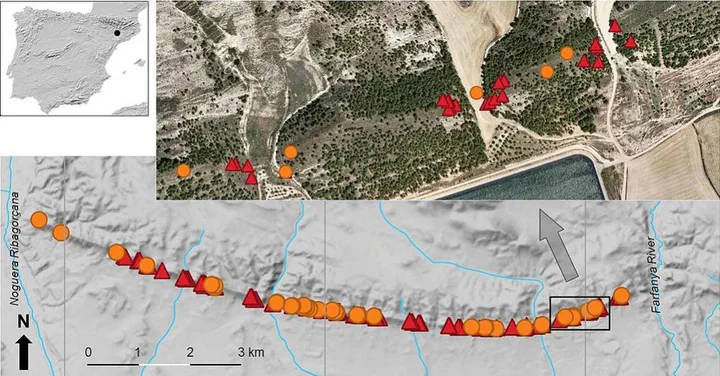Mining tools from the prehistoric quarries in Serra Llarga (NE Iberia): Preliminary results from lithological and techno-morphological approaches
Aug 15, 2025·
,
,
,
 ,
,
·
0 min read
,
,
·
0 min read
X. Terradas
D. Ortega
C. Fernández
A. Minguell
Carlos Rodríguez Rellán
R. Rosillo
C. Roqué
 Fig. 5. Digital terrain map with the location of quarry faces (triangles) and mining tools (circles) documented in Serra Llarga hills (IGN source), and detail of Montvell quarries area.
Fig. 5. Digital terrain map with the location of quarry faces (triangles) and mining tools (circles) documented in Serra Llarga hills (IGN source), and detail of Montvell quarries area.
Abstract
The Montvell quarries form an archaeological site specialized in the procurement of flint nodules for the production of knapped lithic tools. Excavations and studies carried out so far suggest exploitation based on the recurrence of discrete episodes throughout the Mesolithic and Neolithic. These quarries are not an isolated case, since the surveys carried out along the entire 12 km length of Serra Llarga mountain range have allowed us to record more than 100 quarry faces. The similarity of their formal characteristics and the type of associated mining tools lead us to propose a prehistoric chronology for the entire quarrying operation. All these discoveries highlight the importance of this mining complex in the supply of flint in the Iberian northeast throughout prehistory. During a survey carried out in the 2020 fieldwork season we recovered a significant number of mining tools (n = 50), both on the surface and associated with quarry faces located within the area studied archaeologically. The blanks of these tools are cobbles, without any type of modification, obtained from alluvial deposits outcropping near the slopes of Serra Llarga. The choice of blanks was based on their lithology, weight and morphology. Their lithologies correspond to tenacious materials, mainly quartzite, as well as other metamorphic, igneous and sedimentary rocks. A first morphotechnical approach reveals that there are no perceptible differences among the tools according to their shape and weight. Although there is certain diversity in their weight, they are presented ordered, without significant groupings that would allow us to establish types of tools based on discontinuities. Bearing in mind the extremes, it could be established that some may be regarded as heavy sledgehammers linked to the hard work of dismantling the calcareous strata that contain the flint nodules, whereas others could correspond to hammerstones used to remove limestone remains adhering to the surface of flint nodules, to test them, or in preliminary knapping operations.
Type
Publication
Journal of Archaeological Science: Reports, 67, 105361